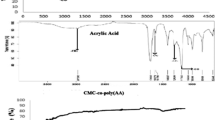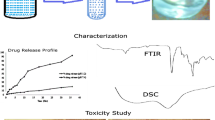Abstract
Purpose
Colorectal cancer (CRC) is the third leading cause of cancer death in Taiwan; it ranks top three in the cancer mortality rate. Curcuminoids are derived from the rhizome of Curcuma longa. It has shown anti-cancer activity and apoptosis induction in a variety of cancer cell lines. This aims to study the potential of Poloxamer 407 as the thermogelling and mucoadhesive polymer for development of a site-targeting delivery system to enhance the localized delivery of curcuminoids to the colorectal cells for CRC chemotherapy.
Methods
The mucoadhesive strength and rheological properties were measured as a function of poloxamer loaded with curcuminoids.
Results
The gelation temperature of Poloxamer 407 was found to vary with its concentration and start gelling at 37°C at the concentration of 15.5% (w/v). To ensure gelation at physiological temperature after intra-rectal application, gelation temperature was determined by rheological measurement as well as by its physical appearance. The results indicated that its mucoadhesive strength also shows a dependency on temperature, which appears to be related to the increment in the maximum strength and average strength of the polymer.
Conclusion
The results have suggested that Poloxamer 407 could be a potential thermogelling and mucoadhesive polymer for the development of a site-targeting colorectal drug delivery system for curcuminoids in colorectal cancer therapy.

Poloxamer 407 could be a potential polymer for the development of a site-targeting colorectal drug delivery system (DDS) for curcuminoids in colorectal cancer therapy.





Similar content being viewed by others
References
Ray A (2005) Cancer preventive role of selected dietary factors. Indian J Cancer 42:15–24
Khor TO, Keum YS, Lin W et al (2006) Combined inhibitory effects of curcumin and phenethyl isothiocyanate on the growth of human PC-3 prostate xenografts in immunodeficient mice. Cancer Res 66:613–621
Hsu YC, Weng HC, Lin S, Chien YW (2007) Curcuminoids-cellular uptake by human primary colon cancer cells as quantitated by a sensitive HPLC assay and its relation with the inhibition of proliferation and apoptosis. J Agric Food Chem 55:8213–8222
Lin YT, Wang LF, Hsu YC (2009) Curcuminoids suppress the growth of pharynx and nasopharyngeal carcinoma cells through induced apoptosis. J Agric Food Chem 57:3765–3770
Sinha R, Anderson DE, McDonald SS, Greenwald P (2003) Cancer risk and diet in India. J Postgrad Med 49:222–228
Perkins S, Verschoyle RD, Hill K et al (2002) Chemopreventive efficacy and pharmacokinetics of curcumin in the min/+ mouse, a model of familial adenomatous polyposis. Cancer Epidemiol Biomarkers Prev 11:535–540
Marczylo TH, Steward WP, Gescher AJ (2009) Rapid analysis of curcumin and curcumin metabolites in rat biomatrices using a novel ultraperformance liquid chromatography [UPLC] method. J Agric Food Chem 57:797–803
Inoue K, Nomura C, Ito S, Nagatsu A, Hino T, Oka H (2008) Purification of curcumin, demethoxycurcumin, and bisdemethoxycurcumin by high-speed countercurrent chromatography. J Agric Food Chem 56:9328–9336
Wichitnithad W, Jongaroonngamsang N, Pummangura S, Rojsitthisak P (2009) A simple isocratic HPLC method for the simultaneous determination of curcuminoids in commercial turmeric extracts. Phytochem Anal 20:314–319
Yang KY, Lin LC, Tseng TY, Wang SC, Tsai TH (2007) Oral bioavailability of curcumin in rat and the herbal analysis from Curcuma longa by LC-MS/MS. J Chromatogr B Analyt Technol Biomed Life Sci 853:183–189
Sharma RA, Steward WP, Gescher AJ (2007) Pharmacokinetics and pharmacodynamics of curcumin. Adv Exp Med Biol 595:453–470
Chearwae W, Anuchapreeda S, Nandigama K, Ambudkar SV, Limtrakul P (2004) Biochemical mechanism of modulation of human P-glycoprotein (ABCB1) by curcumin I, II, and III purified from Turmeric powder. Biochem Pharmacol 68:2043–2052
Shibata H, Yamakoshi H, Sato A et al (2009) Newly synthesized curcumin analog has improved potential to prevent colorectal carcinogenesis in vivo. Cancer Sci 100:956–960
Yadav VR, Suresh S, Devi K, Yadav S (2009) Novel formulation of solid lipid microparticles of curcumin for anti-angiogenic and anti-inflammatory activity for optimization of therapy of inflammatory bowel disease. J Pharm Pharmacol 61:311–321
Harris LR, Roberts L (2008) Treatments for irritable bowel syndrome: patients' attitudes and acceptability. BMC Complement Altern Med 8:65
El-Kamel A, El-Khatib M (2006) Thermally reversible in situ gelling carbamazepine liquid suppository. Drug Deliv 13:143–148
Uzunkaya G, Bergişadi N (2003) In vitro drug liberation and kinetics of sustained release indomethacin suppository. Farmaco 58:509–512
Yong CS, Oh YK, Kim YI et al (2005) Physicochemical characterization and in vivo evaluation of poloxamer-based solid suppository containing diclofenac sodium in rats. Int J Pharm 301:54–61
Chen Y, Li G, Huang JG, Wang RH, Liu H, Tang R (2009) Comparison of self-microemulsifying drug delivery system versus solid dispersion technology used in the improvement of dissolution rate and bioavailability of vinpocetine. Yao Xue Xue Bao 44:658–666
Gelperina S, Maksimenko O, Khalansky A et al (2010) Drug delivery to the brain using surfactant-coated poly(lactide-co-glycolide) nanoparticles: influence of the formulation parameters. Eur J Pharm Biopharm 74:157–163
Paek SH, Xuan JJ, Choi HG et al (2006) Poloxamer 188 and propylene glycol-based rectal suppository enhances anticancer effect of 5-fluorouracil in mice. Biol Pharm Bull 29:1060–1063
Koffi AA, Agnely F, Ponchel G, Grossiord JL (2006) Modulation of the rheological and mucoadhesive properties of thermosensitive poloxamer-based hydrogels intended for the rectal administration of quinine. Eur J Pharm Sci 27:328–335
Chen MJ, Lin YW, Cheng YM et al (2011) Early experimental results of colorectal carcinoma chemotherapeutics by liposomal curcuminoids. Dig J Nanomater BIOS 6:1445–1456
Huang TY, Hsu CW, Chang WC et al (2012) Demethoxycurcumin (DMC) retards cell growth, and induces apoptosis in human brain malignant glioma GBM 8401 cells. eCAM (in press)
Chien YW, Lin S (2002) Optimisation of treatment by applying programmable rate-controlled drug delivery technology. Clin Pharmacokinet 41:1267–1299
Acknowledgment
The authors appreciate the funding support provided by the National Science Council (Taiwan) (grant NSC94-2745-B-037-011-URD) and (NSC100-2313-B-309-001). The authors are also grateful to the technical assistance provided by Prof. YIE W. CHIEN of InnovaTherapeutics Research Center in Kaohsiung Medical University.
Conflict of interest
There is no conflict of interest.
Author information
Authors and Affiliations
Corresponding author
Rights and permissions
About this article
Cite this article
Chen, MJ., Cheng, YM., Lai, PH. et al. In vitro biocompatibility of thermally gelling liquid mucoadhesive loaded curcuminoids in colorectal cancer chemoprevention. Int J Colorectal Dis 27, 869–878 (2012). https://doi.org/10.1007/s00384-011-1393-3
Accepted:
Published:
Issue Date:
DOI: https://doi.org/10.1007/s00384-011-1393-3




